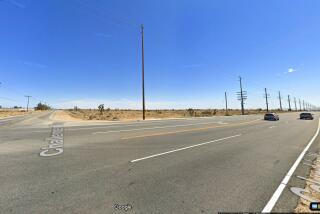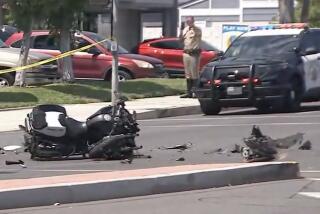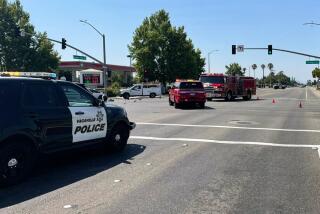30 Investigators Seeking Killer of O.C. Officer
GARDEN GROVE — More than 30 police investigators spent Wednesday chasing leads and examining fingerprints taken from a stolen motorcycle in their search for the killer of a veteran patrol officer.
Garden Grove police said they were confident that the gray Kawasaki motorcycle found abandoned not far from the shooting scene is linked to the slaying early Tuesday of Officer Howard E. Dallies Jr., 36. But they said they need more evidence to be sure the motorcycle was the getaway vehicle.
Police also said they are hopeful that fingerprints taken from the stolen vehicle can be traced through a statewide computer system.
As of late Wednesday, however, investigators had no suspects in the killing of Dallies, who was shot in the lower stomach on a quiet residential street in north Garden Grove.
The slain officer’s wife, Irvine police dispatcher Mary Dallies, surrounded herself during the day with relatives as co-workers and friends streamed through her parents’ house in Garden Grove.
“The hardest thing for me was not being able to tell him goodby,” Dallies said, alternating between tears and smiles as she relived memories of her husband in her first public comments since the shooting. “But I know he loves me and he loves our children and our family and he’s watching us.”
The gray Kawasaki motorcycle, which carried a stolen license plate from another vehicle, was reported stolen from an address on Maureen Drive here about a week before the shooting. It matched the description Dallies gave before he lost consciousness and died in an Orange County trauma center.
“There are a lot of coincidences,” Lt. J.A. Woods said of the motorcycle. “If it ends up not being the proper motorcycle, we’ll be surprised.”
Authorities said they do not consider the owner of the stolen motorcycle or the owner of the stolen license plate suspects in Dallies’ slaying. Police said they conducted a telephone interview late Tuesday with the motorcycle owner, who was in Arizona. They have also contacted the owner of the license plate.
Police declined to release the number of the stolen plate or identify either the owner of either the motorcycle or the license plate, saying the investigation was continuing.
Woods said police believe the suspect they are seeking had been riding the stolen motorcycle for at least a day before the shooting. He encouraged anyone who may have seen such a bike to contact police.
Homicide investigators now believe that Dallies was stopping the motorcyclist at the time he was shot. A day earlier, they had speculated that the incident could have been either a traffic stop or a chance encounter with the motorcyclist.
Dallies was shot three times on Aldgate Avenue, just off Brookhurst Street, police said. The fatal round tore into his midsection just below the bulletproof vest the department requires officers to wear. Neighbors, awakened by the shooting, rushed out into the street and called for police at 2:46 a.m. Tuesday.
Outraged over the slaying, homicide investigators from around Orange County offered to aid Garden Grove police in their investigation. Garden Grove detectives, meanwhile, were busy chasing down tips called in by residents. But so far, police said, none of the tips has panned out.
Dallies’ death, the fifth of a Garden Grove officer in the department’s history, intensified concern at police departments throughout Orange County about officer safety. In Garden Grove, the incident prompted officials to consider equipping more patrol cars with video cameras, which could provide an added measure of protection.
Although some Garden Grove police cruisers are equipped with the video cameras, Dallies’ car was not.
Dallies’ fellow officers continued to mourn him. “It’s like you’ve lost a member of your family unexpectedly,” Police Chief Stanley L. Knee said.
“We try to talk about it and try to remind ourselves that this is an absolute tragedy but we’ve also got a job to do,” Knee said.
But police had few details about the stop, because Dallies did not radio dispatchers with his location or a description of the motorcycle before leaving his police cruiser.
That in itself was unusual, police say, because Dallies had been in contact with department dispatchers throughout his shift. The last communication came just four minutes before the shooting was reported, when Dallies sent a computer message to dispatchers. About 26 minutes before that, he had radioed dispatchers as he stopped a vehicle at Chapman Avenue and Euclid Street, police said.
In his contact with dispatchers about 30 minutes before the shooting, Dallies was following department policy by radioing dispatchers as he prepared to stop the vehicle.
The next contact came at 2:42 a.m., when Dallies sent a message from his cruiser’s mobile computer regarding another unrelated call, police said.
Without knowing the circumstances Dallies faced, the police chief declined to second-guess the officer for not calling in his position when he stopped the motorcycle.
“We will perhaps never know the details leading up to this . . . stop,” Knee said.
“We will never know what those conditions were, so we would never critique an individual officer and say he should have done this and he should have done that. . . . We don’t know if he had the opportunity to call in,” Knee said.
While it was not immediately clear how Dallies came into contact with the motorcyclist, detectives said they believe he did force the motorcyclist to pull over.
Capt. David Abrecht said officers based their conclusion on interviews with people in the area and the position of the police car in the street. Detectives, however, have no witnesses to the shooting and no motive for it.
Police Department analysts quickly zeroed in on a possible match with fingerprints from the impounded motorcycle because Garden Grove is one of five police agencies in the county with a terminal for Cal-ID, the high-technology computer system that helps match prints with a statewide database.
Woods said the Cal-ID system “is critical” to the investigation into Dallies’ death.
Prints are photographed, enlarged, traced, photographed again and then reduced before being entered into the computer, Woods explained. Then the prints are compared with those of convicts or arrestees in the database, and analyzed on a 999-point scale. While there is never an exact match, the Cal-ID system helps narrow the search, police said.
Woods said the machine has come up with several prints similar to those found on the motorcycle, but that further examination of each print is necessary.
“The computer part of it is relatively fast, but . . . it’s not a five-minute thing,” Woods said. “We’re trying to do some further enhancing to follow up.”
Dallies’ family members and Police Department officials scheduled a viewing of the officer’s body on Sunday at Dimond & Sons Mettler Mortuary in Garden Grove. On Monday there will be a public funeral at 11 a.m. at Crystal Cathedral in Garden Grove, Abrecht said.
Dignitaries from around the county are expected, and there will be a special fly-by helicopter formation before the interment at Westminster Memorial-Park, Dallies’ mother-in-law, Zoe Fruehan, said Wednesday.
RELATED STORIES: A17-19
More to Read
Sign up for Essential California
The most important California stories and recommendations in your inbox every morning.
You may occasionally receive promotional content from the Los Angeles Times.










